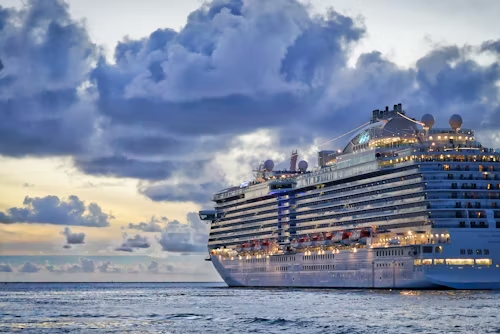Cruise Industry Outpaces Hotels Despite Rising Prices
Cruise lines are becoming a more affordable option than traditional hotels, even with rising prices. Cruises remain cheaper than land-based accommodations, helping them stand out as weaknesses appear in other travel sectors.
Demand for cruises is strong and shows no signs of slowing. The cruise industry, one of the last to recover from the COVID pandemic, is now experiencing robust pricing and booking momentum. While price growth is stabilizing, it remains higher than inflation, according to Truist analyst Patrick Scholes. “Cruise companies are having a moment right now,” Scholes stated in a CNBC interview.
Hilton CEO Christopher Nassetta noted that U.S. leisure travel demand is “flat, maybe even a little down,” highlighting the cruise industry’s contrasting strength. Barclays analyst Brandt Montour emphasized that cruises’ price advantage over land-based vacations, combined with better service levels, drives this sustained demand.
Major cruise operators reported net revenue per diems 17% higher than in 2019. In contrast, Caribbean hotel prices have risen 54% since 2019, and U.S. resort prices are up 24%, according to Montour.
Carnival CEO Josh Weinstein stated that declines in other travel sectors could benefit his company. “If the consumer is slowing down in other sectors, that bodes well for us to attract those customers,” Weinstein said, citing cruises’ better pricing and experience.
Cruises’ Price Edge and Growth Opportunities
The price gap between cruises and hotels isn’t new, as hotels cater to business travelers while cruises target leisure travelers, who are more price-sensitive. However, this gap has widened in recent years, creating more growth potential for cruise lines, said UBS analyst Robin Farley.
Farley noted that increased direct bookings for cruises since 2019 mean fewer commissions paid to travel agents, affecting per diem figures. A 5-10% increase in direct bookings could significantly boost reported net per diems, she estimated.
Cruise operators have also expanded bundled and presold onboard revenue, widening the price gap with hotels. Farley sees further potential for Royal Caribbean, citing its private island, CocoCay, which features paid attractions that generate additional revenue.
All three major cruise lines are introducing high-speed internet via Starlink, which could increase passenger revenue. Farley commented, “The wider that gap, the better the opportunity for cruise lines.”
Truist’s Scholes emphasized that cruise operators’ profitability depends on price increases due to their high fixed costs. “One extra point of pricing is extremely material to profitability,” he explained.
Wall Street analysts maintain a positive outlook for cruise operators. Scholes noted that cruises now compete against theme parks and other vacation destinations, not just rival cruise lines.
Royal Caribbean has raised the bar with CocoCay’s paid amenities and its new ships, such as the Icon of the Seas and Utopia of the Seas. These ships are designed to attract first-time cruisers with short getaway options.
Royal Caribbean and Carnival have “overweight” ratings from analysts. Royal Caribbean’s stock is up nearly 56% year-to-date. Carnival recently posted record operating income and raised its 2024 earnings estimates, driven by strong demand and cost-cutting measures.
Carnival’s upcoming island, Celebration Key, set to open in July, is expected to boost interest and bookings. However, Carnival faces pricing competition from private cruise operator MSC. Carnival’s stock has risen about 13% this year, lagging behind the S&P 500’s 22% increase.
Norwegian Cruise Line Holdings also holds an “overweight” rating, with analysts forecasting a 4% upside to its average price target. Citi recently upgraded Norwegian’s stock, raising its price target and highlighting growth potential.
Norwegian has not announced a private island, but Scholes predicts it will introduce one by 2026. Norwegian’s stock has underperformed, up about 16% year-to-date.
Cruise lines continue to position themselves as affordable, attractive alternatives in the travel industry. Strong demand, price advantages, and growth potential signal continued momentum for the sector.


